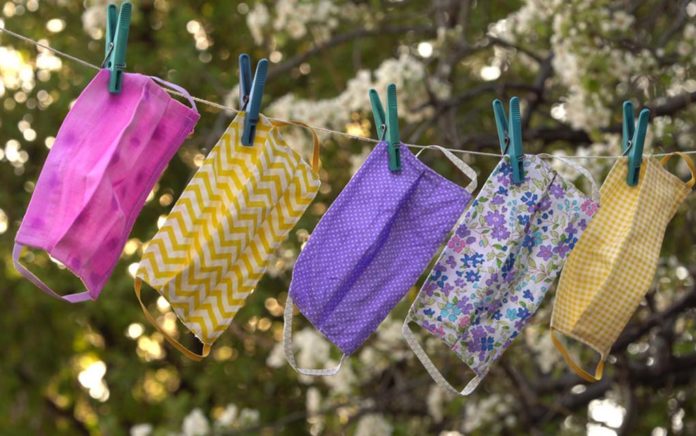
(GoHealthier.com) – Our knowledge of facemasks has come a long way since the pandemic began. We now understand how we can protect each other from COVID-19 by wearing facial coverings.
But experts say there’s more to safe facemask use than simply wearing them. Sanitizing facemasks has become an important step in staying healthy during the pandemic. Learn all about sanitizing facemasks below.
| Quick Read: We may sanitize cloth facemasks by either machine-washing or hand-washing in a bleach mixture. To sanitize medical-grade facemasks, leave them in closed paper bags for a minimum of seven days. Read the full article for more information on how to sanitize facemasks, as well as face shields. |
Learn How to Sanitize Facemasks.
Why Do We Need to Sanitize Facemasks?
By wearing facemasks, we are playing an active role in helping everyone stay healthy during the coronavirus pandemic. But what happens if someone with COVID-19 coughs, sneezes, or even talks near us?
If our facemask has become contaminated, wearing it again could turn that facial covering from a germ barricade to a disease spreader. Just touching a contaminated mask and then reaching up to scratch your nose or wipe your mouth could turn into a COVID-19 infection.
Consequently, health specialists urge us to sanitize our facemasks after usage. Learn how to sanitize cloth facemasks, medical-grade facial coverings, and face shields below.
Sanitizing Cloth Facemasks
Reusable cloth facemasks have become increasingly popular. We can purchase them or even make our own facial coverings. And by choosing different fabrics, we can even let our individual personalities shine through.
The Centers for Disease Control and Prevention (CDC) recommends two options for sanitizing cloth face coverings:
Option 1: Washing Machine and Dryer
- Add your cloth facemask to your load of laundry.
- Use your normal laundry detergent, but be sure to choose the highest possible water temperature for the facemask cloth type. For example, warm water rather than hot or cold typically is suited to face coverings made from knit materials.
- When the machine cycle is completed, put your facemask in your dryer at a high heat setting. Make sure it is totally dry before removing it.
Option 2: Hand Wash and Air Dry
- Using skin protection, such as gloves, create a bleach solution with 5 tablespoons of 5.25 to 8.25 percent sodium hypochlorite to one gallon of room temperature water.
- Leave your facemask in that mixture for five minutes.
- Remove and rinse the mask thoroughly using room temperature or cold water.
- Air dry your mask by leaving it flat on a surface in direct sunlight, if possible.
Sanitizing Medical-Grade Facemasks
In contrast to cloth facemasks, medical-grade facemasks should not be washed. To sanitize a medical-grade facemask such as an N95, follow these steps:
- Put the facemask into a paper bag.
- Leave the facemask in the closed bag for a minimum of seven days at room temperature.
Sanitizing Face Shields
To add protection when we go outside our homes, some of us are wearing face shields on top of our face masks. We may sanitize face shields by following these steps:
- Use a cleaning wipe or cloth wetted with a detergent solution to wipe the inside of the face shield.
- Use a disinfectant wipe or cloth wetted with a disinfectant mixture to wipe the outside of the face shield, then wipe with water.
- Air-dry the face shield.
To remember to sanitize face masks, it may help to think of a used facemask like handkerchiefs you’ve sneezed into. You’ll want to handle them with care and wash your hands thoroughly after touching them.
We may all contribute to helping to stop the spread of COVID-19 by wearing face masks when appropriate. By sanitizing these facial coverings, we are protecting our own health as well.
~Here’s to a Healthier Life!
Copyright 2024, GoHealthier.com














